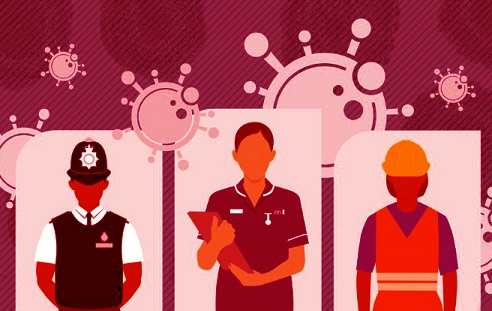Nikhil Prasad Fact checked by:Thailand Medical News Team Nov 22, 2024 1 year, 1 week, 1 day, 6 hours, 50 minutes ago
Health News: A new study led by researchers from Technische Universität Dresden, in collaboration with the Federal Institute for Occupational Safety and Health (BAuA) and the AOK Research Institute (WIdO) in Germany, has highlighted the significant role certain occupations play in the risk of COVID-19 hospitalization. This
Health News report sheds light on how occupations such as healthcare work, bus driving, and even religious roles increased individuals' chances of severe COVID-19 outcomes.
 German Study Shows That Certain Jobs Face Higher Risks from COVID-19
German Study Shows That Certain Jobs Face Higher Risks from COVID-19
The study analyzed insurance data from over 260,000 workers in Germany, revealing critical insights about infection risks across various professions during 2020. Researchers used a robust design that adjusted for variables like age, sex, socioeconomic status, and comorbidities.
Study Design and Scope
The research utilized data from the AOK health insurance group, covering about one-third of Germany’s population. The focus was on workers aged 15 to 70, employed in various sectors, with a subset of 11,202 COVID-19 hospitalizations recorded. Each case was carefully examined alongside 249,707 control participants.
This case-cohort design aimed to uncover how specific job roles influence exposure risks, particularly in environments where remote work was impossible. Using the German Classification of Occupations (KldB), researchers compared risk levels in specific fields against administrative roles, deemed a baseline for low occupational exposure.
Key Findings
-Healthcare Workers at the Forefront
Unsurprisingly, healthcare workers faced some of the highest risks. With a hazard ratio (HR) of 2.74, professionals like nurses, geriatric caregivers, and general medical staff were at significantly elevated risk levels. These roles involve direct exposure to patients, many of whom were likely symptomatic carriers.
-Unexpected High-Risk Occupations
Among the surprising findings, workers in theology and church roles had the highest relative risks, with an HR of 3.05. Clergy members often engaged in community or spiritual outreach, attending to the sick and conducting services under varying COVID-19 restrictions.
-
Public Transportation and Service Industry Vulnerabilities
Bus and tram drivers (HR: 2.46) and passenger transport drivers (HR: 2.00) also exhibited significantly heightened risks. Their continuous interaction with the public in enclosed spaces likely increased transmission opportunities. Similarly, meat processing workers (HR: 2.16) suffered from high rates, possibly due to cold, poorly ventilated workplaces.
-Personal and Domestic Care Roles
Personal care workers like hairdressers and beauticians faced an HR of 1.36. Housekeepers and domestic helpers also showed notable risk increases, reflecting the hazards associated
with intimate, face-to-face service roles.
-Food and Hospitality
Those in gastronomy, including waiters and chefs, had elevated but less drastic risks (HR: 1.32). While restaurants underwent closures during lockdowns, sporadic openings and close customer interactions likely played a part.
Implications for Policy and Prevention
The study’s findings stress the importance of targeted occupational health policies. Workers in high-risk fields, especially those unable to telecommute, require better protection during pandemics. Preventative measures such as enhanced ventilation, mask mandates, and regular testing can significantly lower risks.
Further, recognizing COVID-19 as an occupational disease in specific roles could ensure adequate compensation and health support. This consideration is vital for occupations like meatpacking and transportation, where proving work-related transmission remains challenging under existing frameworks.
Robust Analysis and Context
The study’s strength lies in its detailed adjustments for confounding factors, such as pre-existing conditions and socioeconomic variables. It highlighted how risks persisted even after accounting for these aspects. For instance, age and comorbidities are well-known contributors to severe COVID-19, yet occupational exposure remained a significant risk amplifier.
Despite its comprehensive approach, the research acknowledged limitations. It relied on hospitalization data, which may not fully capture the spectrum of occupational exposure to milder infections. Additionally, private-sector employees outside the AOK system, such as freelancers or high-earning professionals, were not included, potentially underrepresenting certain demographics.
Conclusion
This groundbreaking study underscores the crucial link between occupation and pandemic vulnerability. By identifying high-risk professions, the research offers a roadmap for crafting protective measures tailored to the workplace. Recognizing these occupational hazards and acting on them could prevent similar outcomes in future health crises.
The study findings were published in the peer-reviewed journal: BMC Public Health.
https://link.springer.com/article/10.1186/s12889-024-20706-3
For the latest
Health News, keep on logging to Thailand
Medical News.
Read Also:
https://www.thailandmedical.news/news/unhealthy-plant-based-diets-linked-to-higher-covid-19-risk
https://www.thailandmedical.news/news/scientists-from-university-of-california-discover-higher-covid-19-risk-with-organophosphate-pesticide-exposure
